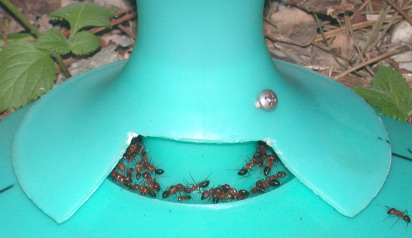Carpenter Ants
Carpenter Ant Control (using Liquid Ant Bait)
Carpenter ants do not eat wood but are thieves by nature and are most active
at night. They forage great distances, as much as 100 yards from their nests,
for honeydew from aphids and other carbohydrates as well as dead insects,
proteins, food scraps and, like other ants, are readily found near water
sources.

Picture of Florida Carpenter Ants feeding at modified AntPro bait station.
 |
 |
| "Foraging carpenter ant workers feed at the AntPro ant bait stations then return to the main nest and satellite nests to feed the colony members by regurgitation. In this way, the toxicant is passed among the colony member, including the queen; thus destroying the colony and its inhabitants."
|
 |
|
 |
Carpenter ants excavate wood in order to create a safe nest for the queens
and brood. In most cases, they prefer moist decaying wood to create their nests.
They have a main nest generally reaching a few thousand inhabitants over a
period of time. They also have satellite nests which contain reproductives,
soldiers, eggs, larvae, pupae and nursery workers. Should the main nest and
queen be destroyed, the satellite nests ensure the colonyís survival. This is
why in many cases, conventional ant control methods are ineffective. It may
seem at first that the carpenter ant problem has been dealt with but, given
time, the ants consolidate and regenerate. After a while they reappear,
frequently, in greater numbers than before.
This constitutes the general scenario whereas the repetitive infestation
leads to structural wood damage from the excavation of new galleries in the
wood. To eliminate carpenter ant infestation, you have to have a plan.
Either late in the evening or early morning before dawn, inspect the exterior
and the interior of your home with a flashlight to look for carpenter ant activity.
Follow a specific inspection
pattern and never when you first find activity conclude your inspection until
you have completed it. Taking into account what you have learned from your
inspection, place AntPro ant bait stations where you have seen
carpenter ants trailing -- it will be obvious to you.
Getting back to their habits; the foraging carpenter ant workers feed at the AntPro
ant bait stations then return to the main nest and satellite nests to feed the colony
members by regurgitation. In this way, the liquid ant bait toxicant is passed among the
colony members, including the queen; thus destroying the colony and its
inhabitants. Because of the low toxicity of the liquid ant bait, the foraging workers
repeatedly feed the other colony members without identifying the baitís
destructive capabilities.
 |
 |
| "Do not under any
circumstances try to use pesticides while the baiting process is ongoing. It
will only serve to alarm the colony and interrupt their feeding."
|
 |
|
 |
It is very important to be patient when using AntPro, with a low toxic ant bait. Give
it time for the active ingredient to be fully distributed throughout the carpenter ant colony. Do not under any
circumstances try to use pesticides while the baiting process is ongoing. It
will only serve to alarm the colony and interrupt their feeding. Give the
ant bait time to work and there will be full ant colony elimination.
After the colony has been eliminated, keep AntPro liquid ant bait stations in place around the
exterior perimeter of your home to keep future carpenter ant infestations from occurring.
Customer Testimonials for Carpenter Ants
Home |
How It Works |
Advantages |
Health & Safety |
Carpenter Ants
Argentine Ants |
Fire Ants |
White Footed Ants |
Other Ants & Insects
Instructions |
Placement |
News |
About Us |
How To Order
Testimonials |
FAQ |
Site Map |
Privacy
KM Ant Pro LLC
P.O. Box 967, Nokomis, FL 34275
(941)445-4252
Contact Us
|



